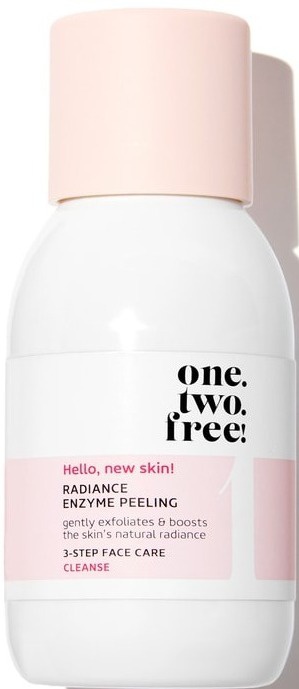
Radiance Enzyme Peeling
Highlights
Key Ingredients
Skim through
| Ingredient name | what-it-does | irr., com. | ID-Rating |
|---|---|---|---|
| Maltodextrin | |||
| Disodium Lauryl Sulfosuccinate | surfactant/cleansing | ||
| Maris Sal | |||
| Aqua | solvent | ||
| Ananas Sativus Fruit Extract | soothing, moisturizer/humectant | goodie | |
| Lactobacillus Ferment | soothing, preservative | goodie | |
| Parfum | perfuming | icky | |
| Punica Granatum Fruit Extract | |||
| Radish Root Ferment Filtrate | antimicrobial/antibacterial, preservative | ||
| Hydrolyzed Gardenia Florida Extract | antioxidant | ||
| Linalool | perfuming | icky | |
| Geraniol | perfuming | icky |
one.two.free! Radiance Enzyme PeelingIngredients explained
It's a little helper ingredient coming from corn, rice or potato starch that can help to keep skin mat (absorbent), to stabilise emulsions, and to keep the product together (binding).
A cleansing agent that's popular in "syndet bars" (soapless soaps) for its good foaming properties. It can also improve the mildness of famously aggressive, irritating surfactant, sodium lauryl sulfate (SLS).
Good old water, aka H2O. The most common skincare ingredient of all. You can usually find it right in the very first spot of the ingredient list, meaning it’s the biggest thing out of all the stuff that makes up the product.
It’s mainly a solvent for ingredients that do not like to dissolve in oils but rather in water.
Once inside the skin, it hydrates, but not from the outside - putting pure water on the skin (hello long baths!) is drying.
One more thing: the water used in cosmetics is purified and deionized (it means that almost all of the mineral ions inside it is removed). Like this, the products can stay more stable over time.
A goodie fruit extract coming from the lovely pineapple. It contains a bunch of good-for-the-skin stuff: bromelain and fruit acids have mild exfoliant properties, and fruit sugars and amino acids give the pineapple fruit nice moisturizing and soothing properties.
There is also a pineapple extract called pineapple ceramide on the market that's claimed to be loaded with a glucose linked ceramide derivative called glucoceramide. According to the manufacturer, glucoceramide is not only a skin moisturizer but it also helps to lighten the skin and make it more smooth.
Lactobacillus ferment is an interesting probiotic ingredient with some promising properties.
First, according to a 2009 Estee Lauder patent, it’s a DNA repair enzyme and it can help to protect the skin against environmental aggressors.
Second, still according to Estee Lauder research but now from 2012 the ingredient has anti-microbial and anti-inflammatory properties and holds promise in the treatment of acne and rosacea. For the former one 5% was needed to show effectiveness, but for reducing skin sensitivity already 1% showed results.
The anti-acne effect is confirmed also by US manufacturer, Barnet, that says that Lactobacillus ferment is helpful in killing harmful bacteria and creating a healthy balanced microflora. Compared to well-known anti-acne and anti-inflammatory salicylic acid the probiotic worked faster at reducing the size and redness of acne lesions.
It also goes by the trade name Leucidal Liquid SF and can serve in the formula as a natural preservative.
Bottom line: It’s not the most proven ingredient (yet) but definitely a very promising one especially if you have sensitive skin, acne or rosacea.
Exactly what it sounds: nice smelling stuff put into cosmetic products so that the end product also smells nice. Fragrance in the US and parfum in the EU is a generic term on the ingredient list that is made up of 30 to 50 chemicals on average (but it can have as much as 200 components!).
If you are someone who likes to know what you put on your face then fragrance is not your best friend - there's no way to know what’s really in it.
Also, if your skin is sensitive, fragrance is again not your best friend. It’s the number one cause of contact allergy to cosmetics. It’s definitely a smart thing to avoid with sensitive skin (and fragrance of any type - natural is just as allergic as synthetic, if not worse!).

It's an alternative, natural preservative that comes from radishes fermented with Leuconostoc kimchii, a lactic acid bacteria that has been used to make traditional Korean dish, kimchi. During the fermentation process, a peptide is secreted from the bacteria that has significant antimicrobial properties.
It is one of the more promising natural preservatives that can be used even alone (recommended at 2-4%), but it's not as effective as more common alternatives, like parabens or phenoxyethanol.

Linalool is a super common fragrance ingredient. It’s kind of everywhere - both in plants and in cosmetic products. It’s part of 200 natural oils including lavender, ylang-ylang, bergamot, jasmine, geranium and it can be found in 90-95% of prestige perfumes on the market.
The problem with linalool is, that just like limonene it oxidises on air exposure and becomes allergenic. That’s why a product containing linalool that has been opened for several months is more likely to be allergenic than a fresh one.
A study made in the UK with 483 people tested the allergic reaction to 3% oxidised linalool and 2.3% had positive test results.
Geraniol is a common fragrance ingredient. It smells like rose and can be found in rose oil or in small quantities in geranium, lemon and many other essential oils.
Just like other similar fragrance ingredients (like linalool and limonene) geraniol also oxidises on air exposure and becomes allergenic. Best to avoid if you have sensitive skin.
You may also want to take a look at...
| what‑it‑does | surfactant/cleansing |
| what‑it‑does | solvent |
| what‑it‑does | soothing | moisturizer/humectant |
| what‑it‑does | soothing | preservative |
| what‑it‑does | perfuming |
| what‑it‑does | antimicrobial/antibacterial | preservative |
| what‑it‑does | antioxidant |
| what‑it‑does | perfuming |
| what‑it‑does | perfuming |





